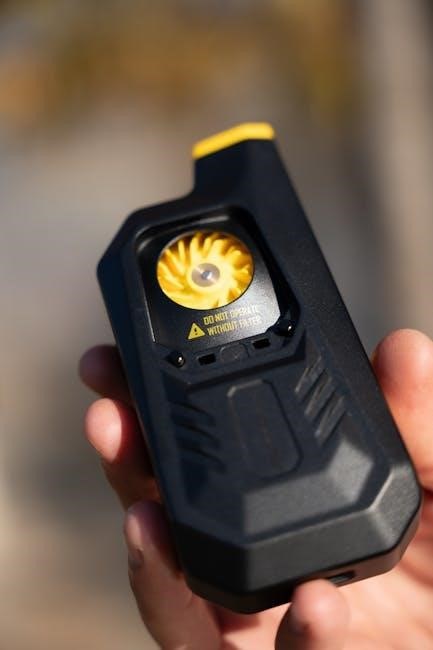Dehumidifier Instruction Manual: A Comprehensive Guide
Welcome to the comprehensive guide for your dehumidifier! This manual provides essential information for setting up, operating, and maintaining your device. By carefully following the instructions, you’ll ensure optimal performance, safety, and longevity of your dehumidifier. Please read thoroughly before use.
Dehumidifiers are essential appliances designed to reduce and maintain the humidity levels in the air. These devices work by drawing in moist air, removing the excess moisture, and then releasing drier air back into the room. This process helps to prevent mold growth, reduce allergens, and create a more comfortable living environment.
Dehumidifiers are particularly useful in damp or humid climates, basements, bathrooms, and laundry rooms. They can also be beneficial for individuals with respiratory issues, as lower humidity levels can alleviate symptoms and improve overall air quality. Choosing the right dehumidifier depends on the size of the space, the severity of the humidity problem, and personal preferences.
There are various types of dehumidifiers available, each with its own set of features and benefits. Understanding the basics of how dehumidifiers work and their different applications will help you make an informed decision when selecting and using one. This manual will guide you through the specifics of your dehumidifier model, ensuring you get the most out of your appliance while maintaining a healthy and comfortable home.
Understanding Your Dehumidifier Model
Before operating your dehumidifier, it’s crucial to familiarize yourself with its specific features and functions. Each model is designed with unique capabilities and controls, ensuring optimal performance and user experience. This section provides an overview of the key components and specifications of your particular dehumidifier model.
Refer to the model number located on the unit’s label to identify the exact specifications in this manual. Pay close attention to the dehumidifying capacity, which indicates how much moisture the unit can remove from the air in a 24-hour period; Understanding this capacity will help you determine if the dehumidifier is suitable for the size of your room or area.
Also, note the type of dehumidifier you have, whether it’s a compressor-based or desiccant model, as this affects its energy efficiency and performance in different temperature conditions. Familiarize yourself with the control panel, settings, and any special features such as auto-restart, smart dehumidifying modes, or air purification capabilities. Knowing these details will ensure you operate the dehumidifier effectively and safely, maximizing its benefits for your home environment.
Safety Precautions
Prioritizing safety is paramount when operating any electrical appliance, including your dehumidifier. To prevent accidents, injuries, or damage to the unit, carefully read and adhere to the following safety precautions.
Always ensure the dehumidifier is placed on a stable, level surface to prevent it from tipping over. Avoid using the unit in areas where it may come into contact with water, such as bathrooms or near sinks, unless specifically designed for such environments. Never insert any objects into the dehumidifier’s vents or openings, as this can damage internal components or cause electrical shock.
Regularly inspect the power cord for any signs of damage, and never use the dehumidifier if the cord is frayed or exposed. Always plug the dehumidifier directly into a grounded electrical outlet that matches the unit’s voltage requirements. Avoid using extension cords or adapters, as they can overload the circuit and pose a fire hazard. When cleaning or servicing the dehumidifier, always disconnect it from the power outlet first. By following these safety guidelines, you can enjoy the benefits of your dehumidifier while minimizing potential risks.
Initial Setup and Placement
Proper setup and placement are critical for optimal dehumidifier performance; Start by unpacking your dehumidifier and removing all packaging materials. Inspect the unit for any visible damage that may have occurred during shipping. If you notice any damage, contact the retailer or manufacturer immediately.
Choose a location for your dehumidifier that is relatively level and provides adequate airflow around the unit. Avoid placing it in enclosed spaces such as closets or behind furniture, as this will restrict airflow and reduce its efficiency. Ensure there is at least 12 inches of clearance on all sides of the dehumidifier. Place the dehumidifier in the area where humidity is most problematic, such as a damp basement or a room with poor ventilation.
Before turning on the dehumidifier, make sure the water tank is properly installed and empty. Some models may require you to install the filter before first use. Once the dehumidifier is in place and all components are properly installed, plug it into a grounded electrical outlet. Follow the operating instructions to turn on the dehumidifier and set your desired humidity level. Remember, proper placement enhances the dehumidifier’s effectiveness.
Operating Instructions
Once your dehumidifier is properly set up, understanding its operation is essential for effective use. Begin by familiarizing yourself with the control panel, typically located on the top or front of the unit. Most dehumidifiers have a power button, humidity setting controls, fan speed adjustments, and mode selection options.
To start the dehumidifier, press the power button. The unit will begin to draw in air and extract moisture. Adjust the humidity setting to your desired level; a lower setting will result in more aggressive dehumidification. Use the fan speed control to adjust the airflow; a higher fan speed will increase the rate of dehumidification but may also increase noise levels.
Many dehumidifiers offer different modes, such as continuous operation, automatic mode, or specific settings for drying clothes. Select the appropriate mode based on your needs. Regularly monitor the water tank level. When the tank is full, the dehumidifier will automatically shut off, and a light will illuminate, indicating that the tank needs to be emptied. After emptying the tank, replace it securely to resume operation. Following these instructions will ensure your dehumidifier operates efficiently and effectively.
Control Panel Functions
Understanding the control panel is crucial to effectively utilizing your dehumidifier’s capabilities. The control panel typically features several buttons and indicators, each serving a specific function. The power button turns the dehumidifier on and off. The mode button allows you to select different operating modes, such as automatic, continuous, or specific drying settings.

Humidity control buttons, often marked with up and down arrows, enable you to set your desired humidity level. The fan speed button lets you adjust the fan’s speed, influencing the rate of dehumidification and noise level. A timer button allows you to set a specific operating duration.

Indicator lights provide feedback on the dehumidifier’s status. A “Tank Full” indicator illuminates when the water tank needs emptying. A “Filter” indicator alerts you when the air filter requires cleaning. Some models may also feature a digital display showing the current humidity level and other relevant information. Familiarize yourself with these functions to optimize the performance and efficiency of your dehumidifier based on your specific needs and environment. Incorrect use of the control panel may affect performance.
Dehumidifying Modes
Dehumidifiers often feature multiple operating modes to cater to various needs and preferences. The most common mode is the automatic mode, where the dehumidifier maintains a pre-set humidity level. Once the desired humidity is reached, the unit will automatically shut off and restart when the humidity rises.
Continuous mode is ideal for situations requiring constant dehumidification, such as after a flood or in consistently damp environments. In this mode, the dehumidifier runs continuously, regardless of the humidity level. Some dehumidifiers also have a “dry clothes” mode, which maximizes airflow and dehumidification to quickly dry laundry indoors.
A “smart” mode is available on certain models. This mode intelligently adjusts the humidity based on the room’s temperature, maintaining a comfortable environment. Manual mode allows users to set the dehumidifier to a specific fan speed and humidity target. Each mode serves a distinct purpose, offering flexibility in managing humidity levels. Selecting the appropriate mode optimizes energy efficiency and ensures effective moisture control based on specific circumstances and user needs. Understanding these differences is key to effective use.
Water Tank Management
Proper water tank management is crucial for the efficient operation of your dehumidifier. Regularly emptying the water tank prevents the unit from shutting down due to being full. Most dehumidifiers have an indicator light or alarm that signals when the tank needs emptying.
To empty the tank, carefully remove it from the unit, ensuring not to spill any water. Dispose of the water in a sink or drain. Clean the tank periodically with mild soap and water to prevent mold or bacterial growth. Ensure the tank is completely dry before reinserting it into the dehumidifier.
Some dehumidifiers offer an alternative drainage option using a continuous drain hose. This allows the unit to operate without manual emptying of the tank. Connect the hose to the designated outlet on the dehumidifier and direct it to a suitable drain. Ensure the hose is positioned correctly to allow for gravity drainage. Regular inspection and maintenance of the hose are necessary to prevent clogs or leaks.
Following these water tank management practices will ensure your dehumidifier operates smoothly and effectively. Proper handling prevents issues and extends the lifespan of the appliance, keeping your environment comfortable.
Cleaning and Maintenance
Regular cleaning and maintenance are essential to ensure the longevity and efficiency of your dehumidifier. Before cleaning, always disconnect the unit from the power outlet to prevent electrical shock. Use a soft, damp cloth to wipe down the exterior surfaces of the dehumidifier. Avoid using harsh chemicals or abrasive cleaners, as these can damage the finish.
The air filter should be cleaned regularly, typically every two to four weeks, depending on usage and environmental conditions. A dirty filter restricts airflow, reducing the dehumidifier’s effectiveness and increasing energy consumption. Remove the filter from the unit, and use a vacuum cleaner to remove dust and debris. For a more thorough cleaning, wash the filter with mild soap and water, ensuring it is completely dry before reinstalling it.
Inspect the water tank regularly for mold or mildew. Clean the tank with a solution of water and a small amount of bleach, rinsing thoroughly afterward. Check the drain hose, if applicable, for clogs or kinks, and clear any obstructions. Periodically inspect the dehumidifier for any signs of damage, such as frayed cords or loose connections. If you notice any issues, contact a qualified technician for repair.
Proper cleaning and maintenance will keep your dehumidifier running smoothly and efficiently, ensuring optimal performance and a healthier indoor environment.
Troubleshooting Common Issues

Even with proper care, you might encounter issues with your dehumidifier. If the unit isn’t turning on, first ensure it’s properly plugged into a functioning outlet. Check the power cord for any damage. If the dehumidifier still doesn’t power on, consult a qualified electrician.
If the dehumidifier is running but not removing moisture, check the air filter. A clogged filter restricts airflow, hindering performance. Clean or replace the filter as needed. Also, ensure the room temperature is within the dehumidifier’s operating range. Low temperatures can reduce efficiency. Verify that the humidity setting is appropriate for the desired level.
If the dehumidifier is making unusual noises, inspect the fan for obstructions. Debris can cause rattling or grinding sounds. If the noise persists, contact customer support.
If the water tank isn’t filling, ensure the unit is level. An uneven surface can prevent proper drainage. Also, check the drain hose, if applicable, for kinks or blockages. If the “Tank Full” indicator is illuminated, empty the tank, ensuring the float mechanism moves freely.
If problems persist after troubleshooting, refer to the warranty information or contact customer support for assistance. Do not attempt to repair the dehumidifier yourself, as this can void the warranty and pose safety risks.
Storage Instructions
Proper storage is crucial for maintaining your dehumidifier’s condition during periods of non-use. Before storing, always disconnect the dehumidifier from the power outlet and allow it to dry completely. This prevents mold and mildew growth within the unit.
Empty the water tank thoroughly and clean it with mild soap and water. Ensure the tank is completely dry before reinserting it into the dehumidifier. Clean the air filter to remove any accumulated dust or debris. A clean filter ensures better performance when the unit is next used.
If your dehumidifier has a drain hose, disconnect it and drain any remaining water. Clean the hose and allow it to dry completely before storing. Coil the hose loosely to prevent kinks or damage.
Store the dehumidifier in a cool, dry place, away from direct sunlight and extreme temperatures. Cover the unit with a cloth or plastic sheet to protect it from dust and dirt. Avoid storing the dehumidifier in a humid environment, as this can promote mold growth.
When storing, ensure the dehumidifier is in an upright position. Storing it on its side or upside down can damage internal components. By following these storage instructions, you can ensure your dehumidifier remains in good working order for years to come.
Warranty Information
Your dehumidifier is protected by a limited warranty against defects in materials and workmanship from the date of original purchase. This warranty covers parts and labor necessary to repair or replace the unit, at the manufacturer’s discretion, should it prove defective during the warranty period.
The specific duration of the warranty is detailed in the warranty card included with your dehumidifier. Please refer to this card for precise information regarding the length of coverage. To validate your warranty, it is essential to retain your original purchase receipt or proof of purchase.
This warranty does not cover damages resulting from misuse, abuse, neglect, improper installation, unauthorized repairs, or normal wear and tear. It also excludes damages caused by acts of nature, such as floods, fires, or electrical storms.
To initiate a warranty claim, contact the manufacturer’s customer support department, providing your model number, serial number, and proof of purchase. You may be required to ship the dehumidifier to an authorized service center for inspection and repair. The customer is typically responsible for shipping costs to the service center;

The manufacturer’s liability under this warranty is limited to the repair or replacement of the defective unit. In no event shall the manufacturer be liable for any incidental or consequential damages arising from the use of this dehumidifier. Some states or provinces do not allow the exclusion or limitation of incidental or consequential damages, so this limitation may not apply to you.
Contact Information and Support
We are committed to providing excellent customer service and support for your dehumidifier. Should you encounter any issues or have any questions regarding its operation, performance, or maintenance, please do not hesitate to reach out to us. Our dedicated support team is available to assist you.
You can contact our customer support department through several convenient channels. Our website, typically found on the product packaging or warranty card, provides access to a comprehensive FAQ section, troubleshooting guides, and downloadable resources. You can often find answers to common questions and solutions to minor issues on our website.
For more personalized assistance, you can reach us via email. Our email address is listed on our website and in the product documentation. Please provide a detailed description of your issue, along with your dehumidifier model number and serial number, to help us expedite your request.
Alternatively, you can contact us by phone. Our toll-free phone number is available on our website and in the product manual. Our support representatives are available during regular business hours to provide real-time assistance and guidance.
Before contacting support, please have your dehumidifier model number, serial number, and proof of purchase readily available. This information will help us quickly identify your product and assist you more efficiently; We are dedicated to ensuring your satisfaction with our dehumidifier and will do our best to resolve any issues you may encounter.




Leave a Reply
You must be logged in to post a comment.